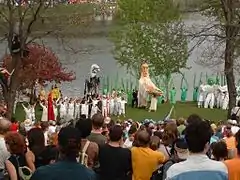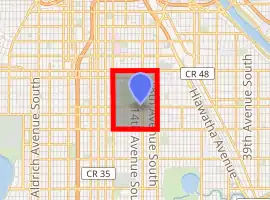Powderhorn Park, Minneapolis
The Powderhorn Park neighborhood of Minneapolis, Minnesota, United States (part of the larger Powderhorn community) is located approximately three miles south of downtown and is bordered by East Lake Street to the north, Cedar Avenue to the east, East 38th Street to the south, and Chicago Avenue to the west. Its namesake is the city's Powderhorn Park facility in the northwestern part of the neighborhood around Powderhorn Lake, which contains playing fields, playgrounds and a park building that hosts community education classes ranging from pottery to yoga. In winter, the Minneapolis Park and Recreation Board sets up a portable warming house and the lake is used for ice skating.
Powderhorn Park | |
|---|---|
 Location of Powderhorn Park within the U.S. city of Minneapolis | |
| Coordinates: 44°56′23″N 93°15′12″W | |
| Country | United States |
| State | Minnesota |
| County | Hennepin |
| City | Minneapolis |
| Community | Powderhorn |
| Founded | 1849 |
| Area | |
| • Total | 0.731 sq mi (1.89 km2) |
| Population (2010)[2] | |
| • Total | 8,655 |
| • Density | 12,000/sq mi (4,600/km2) |
| Time zone | UTC-6 (CST) |
| • Summer (DST) | UTC-5 (CDT) |
| ZIP code | 55407 |
| Area code(s) | 612 |
| Powderhorn Park | |
|---|---|
 Celebration of May Day in 2006 | |

| |
| Type | Urban park |
| Location | Minneapolis, Minnesota |
| Coordinates | 44°56′23″N 93°15′12″W[3] |
| Area | 65.88 acres (26.66 ha) |
| Status | Open all year |
| Historical population | |||
|---|---|---|---|
| Census | Pop. | %± | |
| 1980 | 5,981 | — | |
| 1990 | 7,864 | 31.5% | |
| 2000 | 8,957 | 13.9% | |
| 2010 | 8,655 | −3.4% | |
Developed mainly between 1905 and 1920, it is a residential area consisting of single-family homes, duplexes, and three-story brick apartment buildings. Approximately 9,000 people live in Powderhorn Park. According to the 2000 Census, 42% of the population is white, 22% each black and Hispanic, and 5% each Asian and Native American. Along Lake Street, numerous new and existing Hispanic and African businesses show the area's diversity.
The neighborhood belongs Minneapolis City Council Ward 9, currently represented by Alondra Cano.
The park and lake are used as the setting for the last act in the city's annual May Day parade (actually occurring on the first Sunday in May), which is a play in motion that has been put on by the In the Heart of the Beast Puppet and Mask Theatre since 1975. As the parade runs south along Bloomington Avenue, participants wear a variety of costumes, and many manipulate giant puppets, all to produce a story that is based on sociopolitical themes including peace, environmentalism, current events, and others. After the parade story ends, the tail end of the parade is a "free speech" section which includes representatives of community groups and campaigning politicians. After the parade, there is an intermission as people gather on a hillside at the west end of the park for the Tree of Life ceremony. Many details of the final act change from year to year, but there are several figures that consistently appear: River, Woods, Prairie, Sky, Sun, and the Tree of Life. At the end of the ceremony, a flotilla comes across the lake with the Sun figure in the central boat. The Sun awakens the Tree of Life (a figure which includes a traditional maypole), and the crowd sings "You Are My Sunshine" to mark the banishment of another season of winter.
In 2009, a group of residents started the Powderhorn365 program that documents the day-to-day life of the neighborhood, through a daily photograph from the neighborhood.
In 2020, the neighborhood was the site of the killing of George Floyd.[5] In response, residents of the neighborhood have vowed not to call the police, "doing so, they believed, would add to the pain that black residents of Minneapolis were feeling and could put them in danger."[6] Since then, a camp for those experiencing homelessness has been established in Powderhorn Park, with many tents and over 300 residents.[7] While community members have complained about the camp (which has brought increased vehicle traffic, drugs, property damage, and at least two overdoses) and changed their behavior to avoid it, many remain committed to not involving the police. [8] Instead, community members have delivered meals, medical care, and counseling and sought support from the American Indian Movement to monitor the area.[9]
Notable residents
- Alison Bechdel, cartoonist[10]
- Peter Gross, comic book artist and writer
References
- "Powderhorn Park neighborhood in Minneapolis, Minnesota (MN), 55407 detailed profile". City-Data. 2011. Retrieved 2013-11-12.
- "Minneapolis Neighborhood Profile: Powderhorn Park" (PDF). Minnesota Compass. October 2011. Retrieved 2013-11-12.
- Powderhorn Park, Minneapolis, MN. Google Earth. Retrieved 2011-03-09.
- Powderhorn Park, Minneapolis, MN. Google Earth. Retrieved 2011-03-09.
- "'Being Black In America Should Not Be A Death Sentence': Officials Respond To George Floyd's Death". 2020-05-26. Retrieved 2020-05-27.
- https://www.nytimes.com/2020/06/24/us/minneapolis-george-floyd-police.html
- https://www.nytimes.com/2020/06/24/us/minneapolis-george-floyd-police.html
- https://www.nytimes.com/2020/06/24/us/minneapolis-george-floyd-police.html
- https://www.nytimes.com/2020/06/24/us/minneapolis-george-floyd-police.html
- Metheny, Dave. "March 1990: We profiled 'Fun Home' cartoonist Alison Bechdel during her Minnesota days". Minneapolis Star Tribune. Retrieved 2018-03-09.
External links
| Wikimedia Commons has media related to Powderhorn Park, Minneapolis. |
- Minneapolis Neighborhood Profile - Powderhorn Park
- Powderhorn Park Neighborhood Association
- Minnesota Stories: Powderhorn Park (broken link: archived version)
- Minneapolis Park and Recreation Board: Powderhorn Park
- Powderhorn365 Photography Project
- Parks, Lakes, Trails and So Much More, a history of Minneapolis parks (pages 210-215)